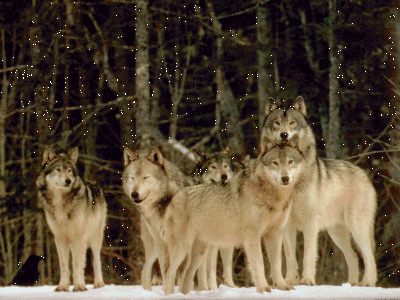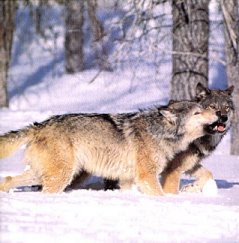
These page is deticated to the wolves, i love them with all my heart, and i hope that after viewing these pages, you too will find a place in your heart to keep them forever.

Definition--
According to the dictionary, wolves are powerful carnivores that once ranged throughout the deciduous and coniferous forests and tundra of the Northern Hemisphere. Broad-chested, with small rounded ears and long legs, wolves are pack hunters, preying on the much larger northern moose, deer and elk herds. In the summer, with the onset of the breeding season and with small mammal prey more readily available, packs break up into smaller groups. Wolf packs have distinct territories. Within the pack there is a complex social structure under a lead (alpha) male and female.
But what lies beyond the dictionary definition of these elusive creatures? Some of the light that experts have shed on this million-year-old quadruped reveals it to be both a superb predator and an excellent caregiver. Such anthropomorphic terms as "affectionate," "self-sacrificing," "loyal" -- even "sensorial," are sometimes used to characterize this animal's behavior.

Pack Life--
Pack size varies from two to 15 individuals. Its mandate is to care for, defend and feed each of its members. The pack's structure and hierarchy governs every individual wolf's existence, behavior and chance for survival. A pack's entire life, breeding and success depend on the availability of prey. As they are able to kill prey ten times their weight, wolves sometimes hunt buffalo. But they have also been known to eat such small fare as mice and moles, and they have even been documented fishing for salmon!
The pack's dominant males and females carry their tails and heads high; subordinate wolves maintain theirs at less lofty heights. Each pack has a designated lowly wolf, referred to as the omega. This wolf is almost always the last to eat and often bears the brunt of the pack members' aggression.
A pack has many functions. It is both a mobile nursery and an efficient hunting machine. Two weeks after giving birth, the alpha female assigns a subordinate pack member to look after her pups while she goes hunting. Scientists refer to the behavior as "aunting." At this time, the pups begin to eat meat regurgitated by their parents and other pack members following the adults' return from a hunt.

When the pups are two months old, the entire pack moves to an open area near forest covering, which is known as a rendezvous site. It is from here that the pack hunts all summer long, leaving the subordinates to watch over the pups. A pack howls to demonstrate fellowship and strength. On a still, clear night the mournful wails can be heard from as far away as ten miles. This is the communication tool that keeps the pack together as they range over large areas.

Behavior--Wolf Moves
With its loose-limbed gait a wolf can cover up to 50 miles in 24 hours. Wolves mark their territories with their scent, from which other wolves gather significant information. From an early age, wolves are taught what and how to hunt during a long apprenticeship with their parents and other pack adults. As a result of this extended childhood, strong bonds develop. In fact, some pups remain with their parents their entire lives.
Though it's infrequent, wolves do sometimes travel alone. Known as a disperser, a solitary wolf, whether male or female, travels solo for a short while, usually in search of a mate with which to begin a new pack.

There was a time when wolves roamed almost every continent, even as far south as India, where they are still found today. Primitive man actually followed the wolf to scavenge food from its kills. Often revered and sometimes reviled, the wolf has symbolized great fear and great hope during different times in history. In Europe, the Christian church chose to use the symbol of the wolf to represent evil. Native North Americans however viewed wolves as kindred spirits in their natural world, imbued with almost supernatural strength. The wolf's prowess as a hunter elevated it to the status of teacher in the never-ending quest for the great buffalo.
By the 19th Century the status of the wolf changed drastically for the worse. European American settlers had significantly depleted wild populations of bison, elk, moose and deer. Because wolves relied on these animals as a primary food source, they turned to sheep and cattle in the absence of natural prey. In order to protect livestock, ranchers and government agencies launched a massive campaign to exterminate wolves from the land. They nearly succeeded; trapping, hunting, poisoning, and killing wolves resulted in their virtual elimination from the lower 48 states by 1965. At the time, the symbiotic relationship between wolves, their prey and the surrounding ecosystem was little understood. But since then, much scientific information has been gathered which has contributed to a greater understanding of the complex role of the predator and the stabilizing effect it has on the health and survival of an entire ecosystem.

Wolf 101--Research
Studying wolves is no easy matter. Scientists and field biologists have found that the best way to keep tabs on wolves is to find out when and what they are eating. Once a wolf kill is discovered it can then be examined. But the sheer size and range of a pack's territory makes finding wolves on the ground almost impossible. The solution is to track wolves from an airplane. From this lofty vantagepoint the animals can be sedated with the use of tranquilizer guns, and then fitted with that radio collars so that their every move can be carefully monitored. Over long periods of time, pack movement, territories, even death can be accurately recorded.
The mapping of wolf activities, whereabouts and status was first accomplished using radio telemetry. The information that has been produced by telemetry reveals that packs live in separate territories averaging 30 to 50 square miles. It has also been discovered that Minnesota wolves disperse from their pack at between one and two years of age, eventually traveling as far as 500 miles to look for a mate and start another pack in an area that was previously without wolves. Now tracking tools include Global Positioning System transmitters fitted onto the collars, the signals of which can be picked up from distances of 30 miles.

Perhaps one of the reasons that human have feared and told
stories about the wolf for so many centuries is because it's behaviors is similar to ours. Wolves are highly social animals that live in family units called packs. Wolf packs usually
consists of a breeding pair, pups of the year, and older offspring. Like humans, some wolves stay with their families until they die, others leave the pack during adolescence in
search of uninhabited territory and a mate. The number of animals in a pack varies depending on the size and availability
of prey in the pack's territory. Packs rarely number more
than 12.Only one pair of animals in a pack mate and produce
pups. Pups are usually born in late April in the Rockies.
The average litter size is 5 to 6. The whole pack participates
in caring for and raising the pups. During the spring and summer all attention is focused on the pups, but in the fall
when the pups are strong enough to keep up, the pack resume sits nomadic existence within the territory.
PAGE 2
DESERT MOON







